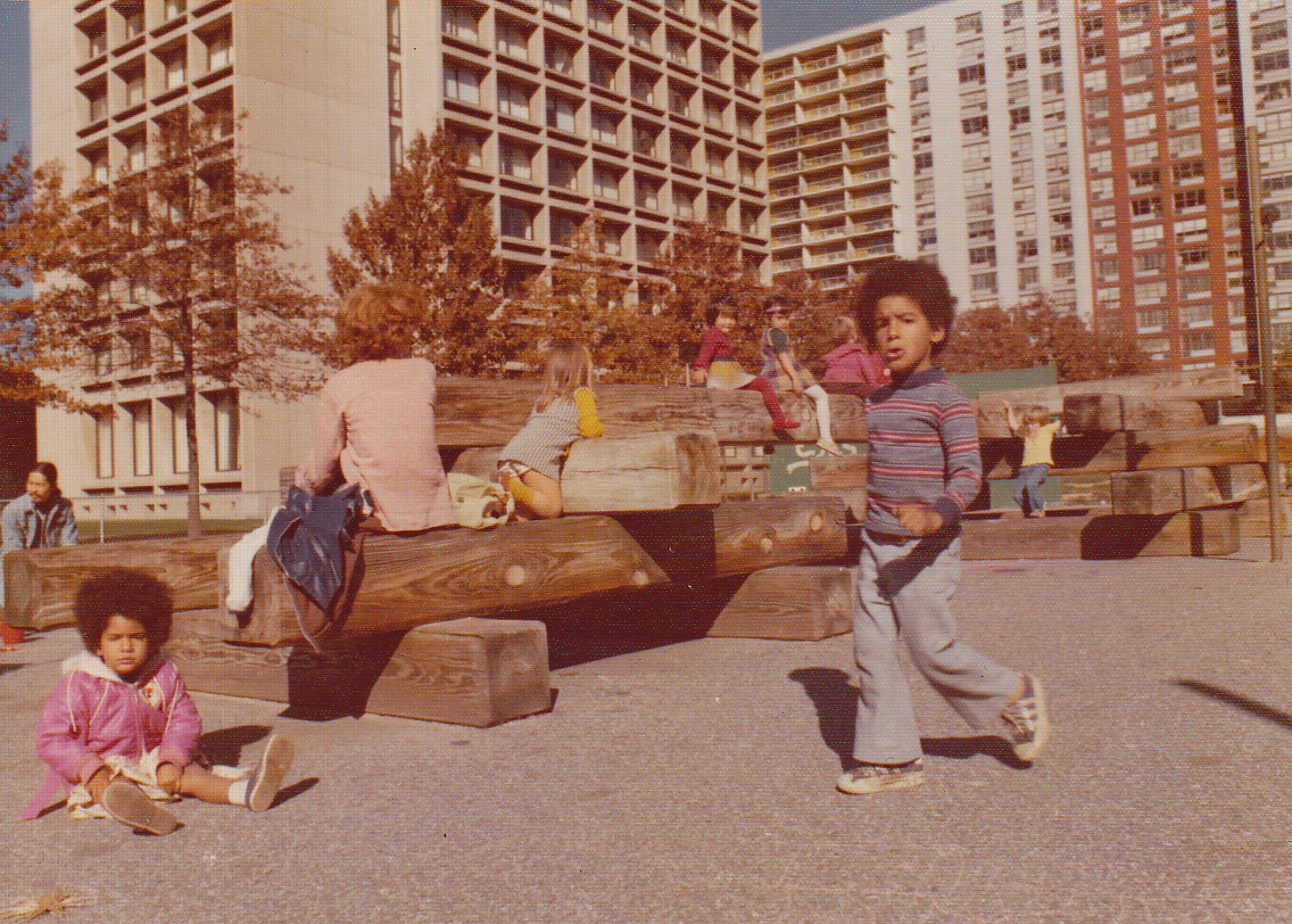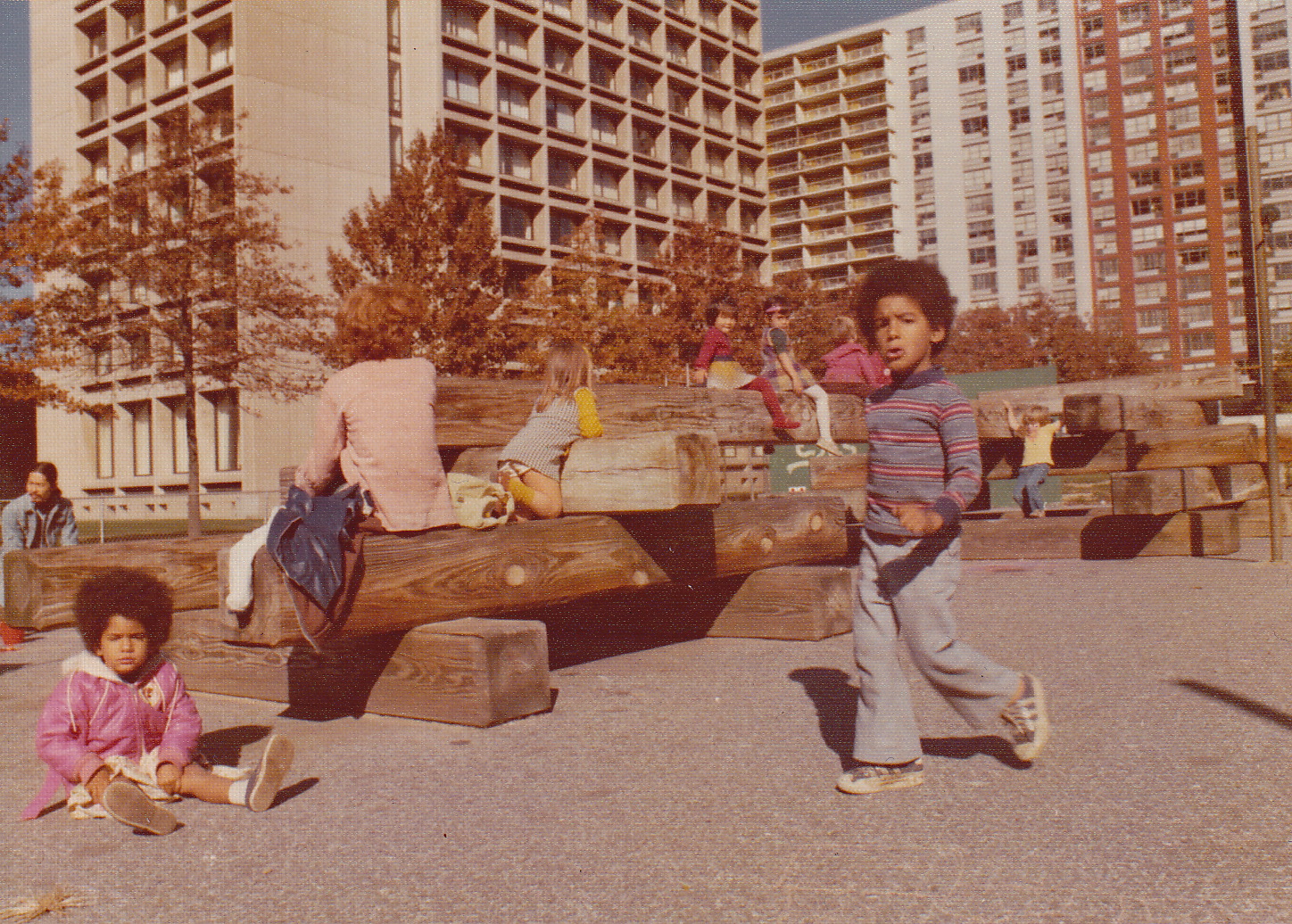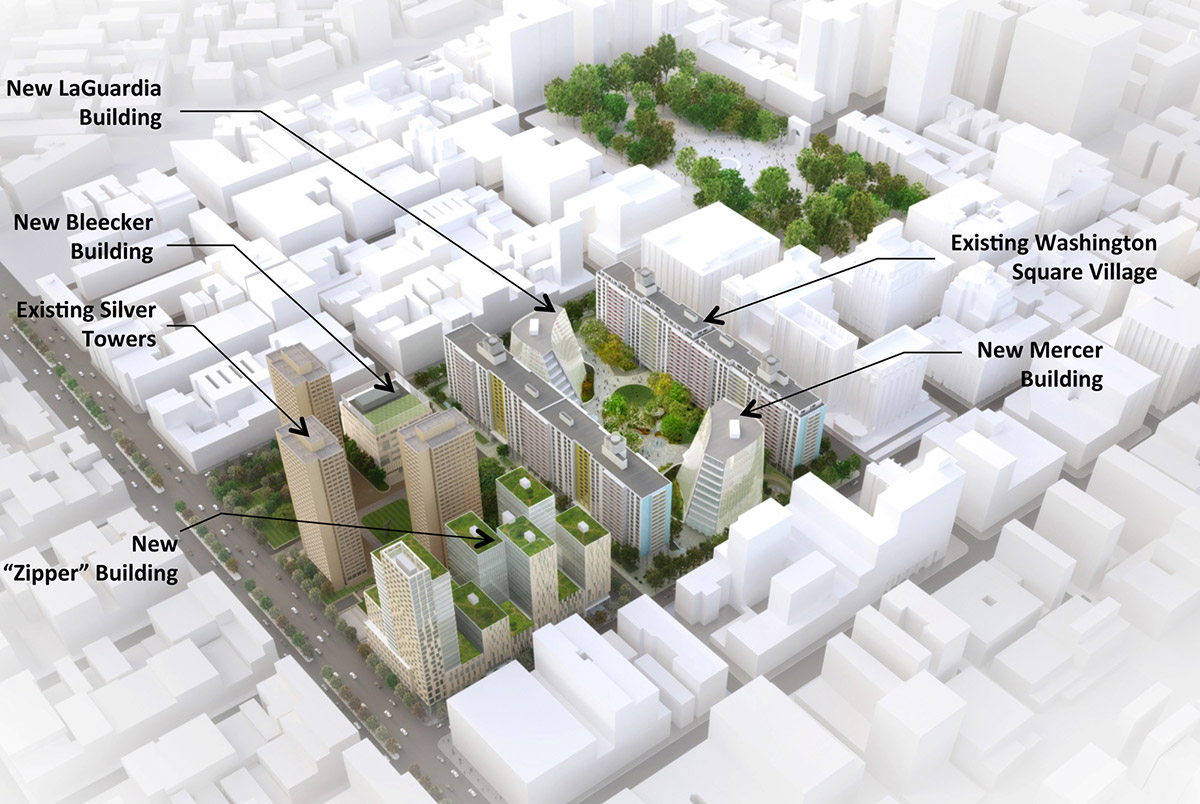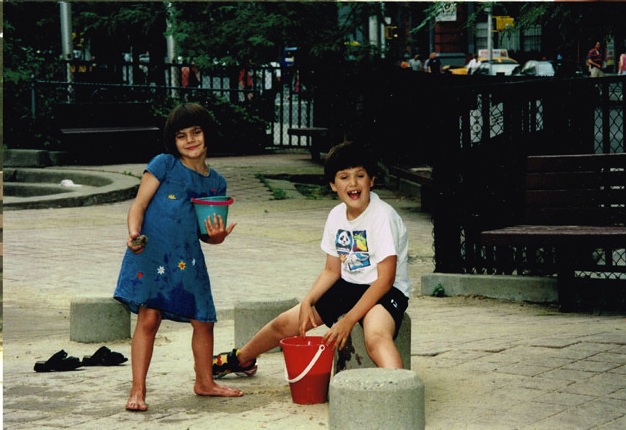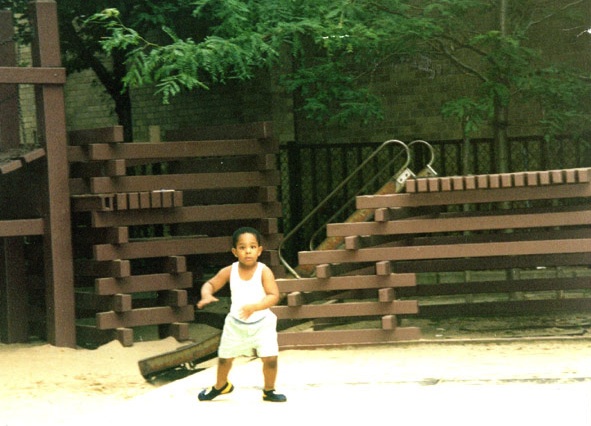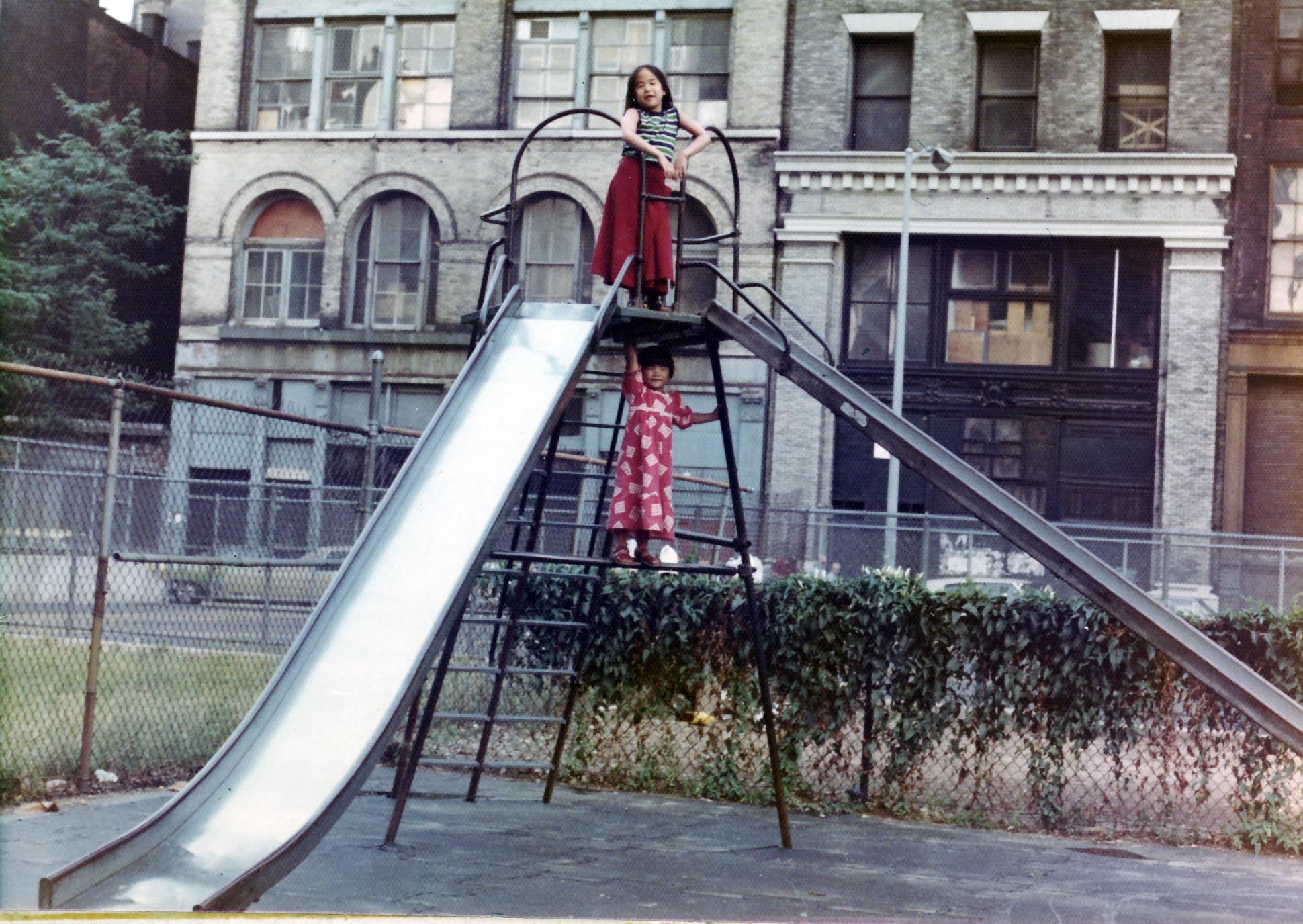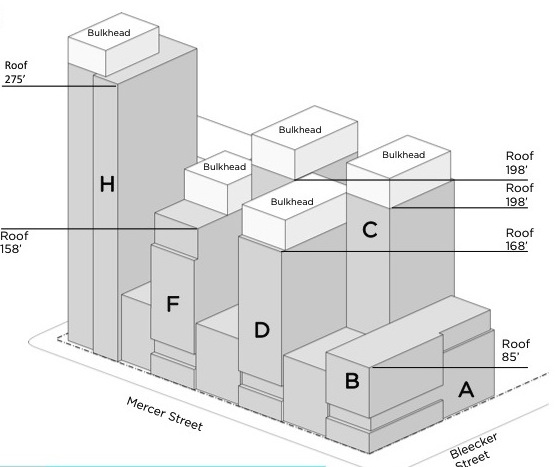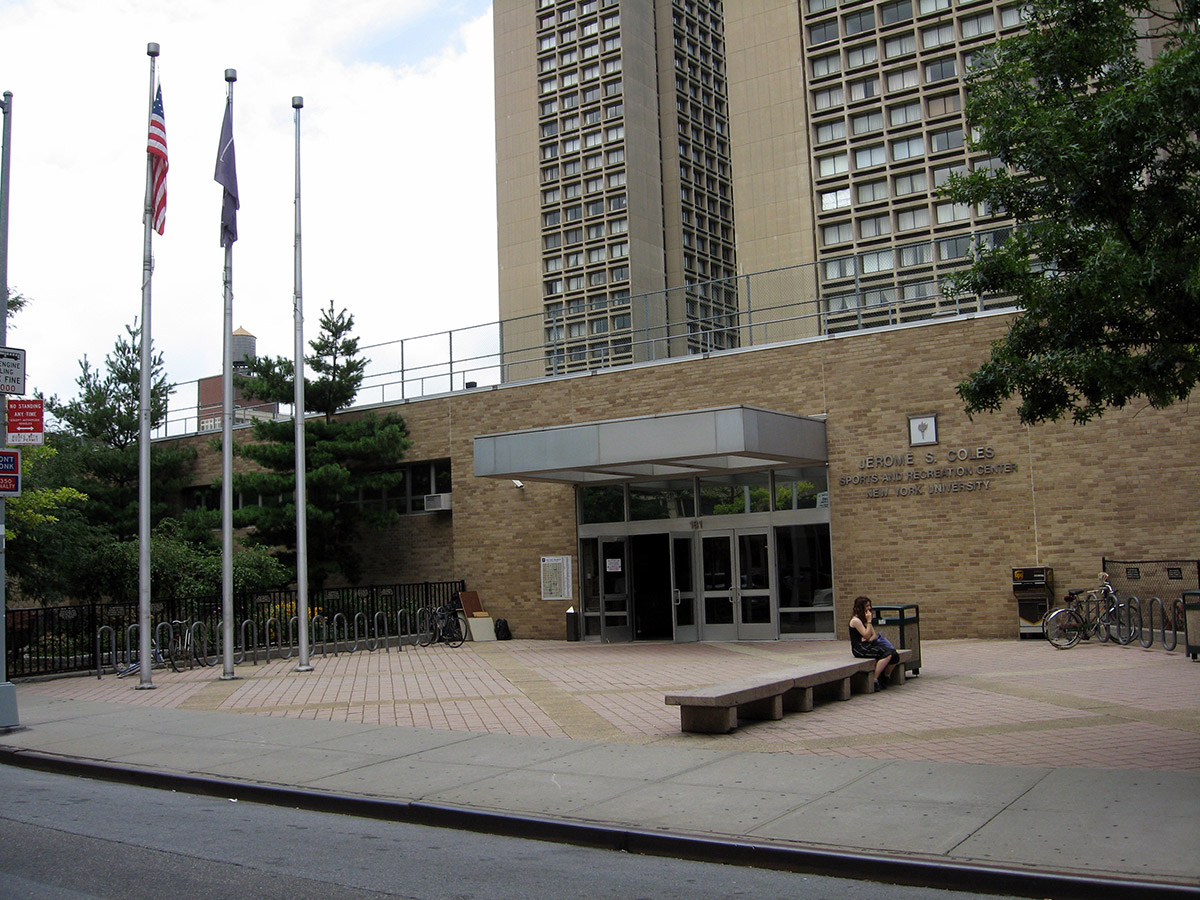The pre-Coles NYU Playground with the Silver Towers behind, ca. 1975
In an age of cities, there is just one village that is known by people the world over: Greenwich Village. It got there by being small. Let’s keep it that way.
I think it’s safe to say that everyone in the neighborhood feels that the NYU Coles Sports and Recreation Center is an eyesore. The windowless, colorless, characterless building that spans the west side of Mercer Street from Houston to Bleecker Street is not only ugly, but the land in front of it, the dog park on the corner and the playground just north of it, whose gates have been chained shut for as long as I can remember, is sinking and is forever in need of repair.
In 2012, when the City Council approved NYU’s “2031 Plan” that sought to add 1.9 million square feet of classrooms, dormitories and office space to the two superblocks where Washington Square Village and The Silver Towers now stand, it looked as if Coles might be replaced by series of tall buildings strung together to form a “Zipper Building” that would house a dormitory, faculty residence, hotel, sports center, retail space, and classrooms. Alarmed by the potential disruption to the neighborhood this would cause, community groups and many NYU faculty were up in arms and protested this proposed expansion, fearing damage to quality of life and the integrity of the neighborhood, not to mention the huge disturbance the construction, which would not be finished until 2031, would cause.
An architect’s rendering of the original proposed plans for new facilities.Photo: AP Photo/New York University (via NY Post)
There were so many questions. Why couldn’t NYU use its already existing space more efficiently? A large number of faculty apartments in Washington Square Village remain empty. Why the need for more faculty housing? Why couldn’t NYU expand out to other neighborhoods and boroughs instead of trying to cram more into an already crowded area? Opposition groups were formed and lawsuits were filed. Then this past January, State Supreme Court Judge Donna Mills surprised everyone by ruling that NYU must get permission from the State Legislature for parts of the school’s superblock expansion plan because it would impact strips of land being used as public parks. This ruling essentially put the kibosh on a large portion of the expansion plan.
“Respondents alienated public park land without approval by the New York State Legislature in violation of the Public Trust Doctrine,” she wrote. According to Sean Sweeney of The SoHo Alliance, a group that has been very active in opposing the 2031 Plan: “The Bloomberg administration claimed that the three parks – LaGuardia Park between Bleecker and West 3rd, Mercer Playground between Bleecker and West 3rd, and LaGuardia Corner Gardens between Bleecker and Houston – were not parks but simply streets under the jurisdiction of the Department of Transportation and not controlled by the Department of Parks. (The strips were created as a result of street-widening in the 1950s for a proposed Lower Manhattan Expressway.)” Mills’ ruling directly contradicted this claim.
This ruling does, however, leave the plot of land where Coles sits open for development and NYU plans to move ahead with construction, though it has scaled back the final square footage of the proposed building (or series of building) and has not yet redesigned the new complex to reflect this change. According to a March 13, 2014 article in The Villager, “Mills ruled that the open-space strip in front of Coles is not public parkland, so N.Y.U. says it maintains the legal right to proceed with its building plans there. The new building slated for the spot would partly sit on the open-space strip currently used by the Mercer-Houston Dog Run. The dog run would be relocated to the west of the new Zipper.”
Children Playing in the park that is not parkland (photo: JMS)
David Gruber, Community Board 2 chairperson, was quoted as saying:
I do not understand, however, why the parkland in front of Coles Gymnasium was not included under the same legal reasoning of ‘park alienation’… That area would have been fully and actively used had N.Y.U. maintained it under their contractual agreement with the community, rather that fencing it off and padlocking it. In any event, I have to assume that this court action will trigger a new ULURP [Uniform Land Use Review Procedure] review.
Conspiracy theories abound. Did NYU padlock that park years ago on purpose to let it default to them? It was used as a playground for a bit (I have photos of children playing there at some point in the past) and then it was locked and left to slowly rot, ostensibly due to unsafe conditions (due to lack of upkeep), even though it is NYU’s responsibility to maintain the park.
Playing in the non-park (photo: JMS)
Come to think of it, wasn’t this very same condemned park the one that they promised the community when NYU proposed building Coles on our old playground in the late-1970’s? (Or was it the other inaccessible playground built on the roof of Coles but never used?) Before Coles, the site housed a baseball field, a basketball court, and a large paved area with a slide, jungle gym, maybe a few other climbing apparatuses, and a huge wooden structure made of enormous pieces of semi-rotten wood that smelled funny when it rained and gave you splinters every time you touched it. Later, a dog run was added on the southeast end of the lot, and a good one-third to half of it toward the Bleecker Street side was a field overgrown with weeds. These were the large open spaces promised when, back in the late-1950’s or early-1960’s, the community opposed the building of the Silver Towers and, I think as a concession, NYU agreed to leave the area surrounding the three buildings as open public space in exchange for permission to build the high rises.
The big slide in the old NYU playground (Mercer Street in background)
It seems that NYU has a pretty good track record of obtaining permission to develop this superblock site. The Silver Towers, then Coles, and now this new yet-to-be-designed multi-purpose building (that people are still referring to as the “Zipper Building”). However, the new building is not a fait accompli just yet. According to a recent article in The New York Times, although NYU says it is going ahead with construction planning:
…Randy M. Mastro, a partner at Gibson Dunn who filed the lawsuit on behalf of the opposition, said it was “delusional” for anyone to argue that one portion of what had been a comprehensive project could move forward alone. “Any such piecemeal approach would constitute a new project materially different from that previously approved by the city and requiring its own separate environmental review and approval process,” Mr. Mastro said. “So N.Y.U. has to go back to Square 1. Its massive project is now dead.”
Let’s just suppose, when all is said and done, the building is built. How will it affect those of us non-NYU residents who live in the area? According to The Villager:
A working group of mostly N.Y.U. faculty members last week issued its recommendations on what should be included in a new building at the current Coles gym site. They suggested a mix of classrooms, performing-arts space, equal space for student and faculty housing, and student study areas, but no retail space. … In addition, the group recommended the creation of a Superblock Stewardship Advisory Committee, which would provide “improved stewardship” by the university of the superblocks land and buildings to “enhance the neighborhood’s quality of life.”
An N.Y.U. graphic of the Zipper Building after it was reduced by 140,000 square feet by the City Council before it O.K.’d the N.Y.U. 2031 superblocks plan in July 2012. In the end, the Council approved a building with 980,000 square feet, with 720,000 square feet of that to be located aboveground.
The idea of having a stewardship committee to advise the university is commendable, as the building would have a huge impact on quality of life in the area. But one must assume that this committee will focus first and foremost on NYU’s quality of life, and who can blame them for that?
A portion of the new building will be used as a dormitory that will house 500 freshmen, as NYU wishes to keep its newest students close to its “Core,” which is what they refer to as the area around Washington Square Park where most classes and school events are held, in order to give them the chance to become part of the NYU community. As someone who went to another NYC school a bit further north where the college itself is dispersed around the city and has no real campus to speak of, there is something to be said for being as close as possible to the center of college life, especially in one’s first year as an undergraduate.
One thing that is puzzling to me is that the working group recommends, at the urging of advocates for Silver Towers residents, that the entrances to the dorms be as far away as possible from the Silver Towers and its plaza, which is faculty housing, so that the faculty and student bodies are not in such close contact. Again, from The Villager:
“While recognizing the clear benefits for freshman students in providing more residential halls in the Core,” the report states, “the Working Group also grappled with the impact of a new freshman dorm in such close proximity to the two faculty housing apartment buildings that comprise Silver Towers. In December 2013, the Silver Towers Tenants Association reported strong apprehension about creating a residential unit for students so close to faculty members and their families.” The working group proposed that the freshmen be kept as far away as possible from the faculty residences: “Entrances to student residence halls should be located on Mercer or Houston Sts., away from the two Silver Towers apartments and the open plaza they share.”
Is this code for NYU professors do not want rowdy freshmen on their doorsteps? Because neither do I, and if the dorm entrances were built on Houston and Bleecker Streets, they basically will open out onto SoHo. This seems contradictory to the idea that the freshmen should be close to the “Core.” Close, but facing away, especially when they come home drunk at 4 AM? The NYU report was presented by four faculty members of the working group, who noted they all live on the superblocks. The Villager article goes on to explain:
As for why — unlike members of N.Y.U. Faculty Against the Sexton Plan — they don’t oppose the project based on its construction impact alone, Laurence Maslon, an arts professor at Tisch School of the Arts, said, “I think saying no to construction is certainly an option, but saying no is not an opportunity. Let’s be honest — nobody likes jackhammers and construction. But we felt this was an opportunity to create something in the core that benefits students, faculty and the university for the long term.”
Coles Sports and Recreation Center
I get it. The Coles Center is an eyesore that no longer serves its intended function and needs to be updated. The space in front of Coles is not being used to its full potential, whatever that is. NYU needs more space. But must they build an entire block of high rise buildings that will house everything from classrooms, to study halls, to residences and dorms, to a theater? It feels a little like they are shoehorning everything they hoped to build over all four sites of the original 2031 plan into the one site that remains open for development.
In response to the working group’s recommendations, my suggestion would be to perhaps use the building either for academic or residential purposes. I, of course, would prefer academic, which would create bustling days but quiet nights. In addition, perhaps some of the space intended for the Coles block could be moved to the commercial strip on Laguardia between Bleecker and Third. That block could use a little help. The land in front of that stretch of low-rise buildings belongs to the Department of Parks, but the buildings themselves are part of NYU. Furthermore, given the Silver Towers Tenants Association’s reaction to the possibility of having NYU freshmen living in close proximity to their buildings, in addition to filling already existing vacant faculty housing, perhaps new faculty housing could be located further away from the Core. I’m sure there are reasons why these things cannot be done, otherwise I assume they would have been done, but you see what I’m getting at.
The density of this block as planned seems unsustainable and uncontainable, and this will inevitably affect the now relatively calm and quiet neighborhood adversely in a way that perhaps no one stewardship committee, no matter how well intentioned, can control. One hopes that if NYU does go ahead with the planned construction, the Superblock Stewardship Advisory Committee will take this “opportunity” to include the community at large as well as its own to create something in the Core that benefits us all.

